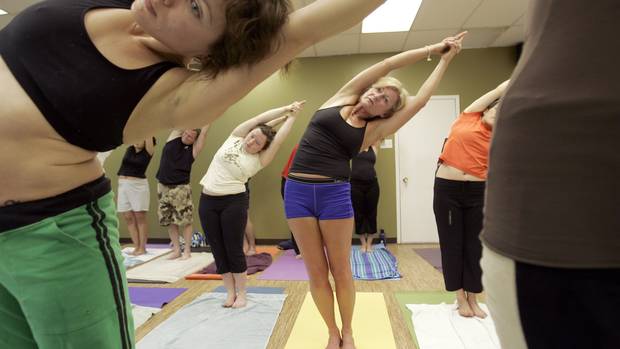
Hot yoga has health benefits, but it’s not for everyone
If you want to improve your flexibility and can tolerate heat – and you’re not pregnant and don’t have high blood pressure, a heart condition, osteoporosis or a disc issue – then hot yoga might be for you.
I survived two classes. One flow class at Iam Yoga with friend and colleague Harry, and one moksha class at Moksha Yoga Danforth with friends Tara and Nate. If destressing in the heat sounds appealing, then you are in luck; you will have no trouble googling a studio near you. In the past, I have tried Bikram at Found City Yoga in Victoria and Moksha Yoga in Montreal, but iterations of hot yoga are offered across the country.
The promise
Moksha Danforth states its class “strengthens, tones and loosens” muscles while simultaneously “reducing stress.” Iam Yoga says the heat allows for “deeper, safer and more effective movements, while also assisting in the detoxification of the body.”
What to expect
Heat. Sweat. Body odour. Did I mention heat? Temperatures range from 32 C to 42 C and classes last 60 to 90 minutes. Harry joked that his shirt was so sweaty it “must weigh a thousand pounds.”
Moksha and flow are very different workouts. Heat aside, I much preferred the flow class; it combines yoga poses with Pilates and “fitness”-style exercises. We did traditional poses and combos – vinyasas, warrior etc. – as well as Pilates-inspired combinations such as a side plank that flowed into a side lunge. I was challenged and far from bored.
Moksha is slower and in no way resembles a traditional group fitness class; it is a mixture of therapeutic and traditional yoga done in a heated room.
The difference between the two classes can be summarized by the number of vinyasas performed. At Moksha, we did maybe five; at Iam, we did more than 20, each paired with a Pilates or core-inspired exercise.
The verdict
Tara, Nate and Harry loved their experiences. I enjoyed exercising with my friends, but as a fitness professional, I am wary of hot yoga.
Too often, yoga – especially hot yoga – is dangerously sold as the panacea for all physical ailments. Yoga requires spinal flexion, rotation and side-bending. If you have osteoporosis or a disc bulge, extremes of these motions can be contraindicated. Plus, not everyone needs increased flexibility; too much mobility can be detrimental. Optimal biomechanics require a balance of strength and flexibility. Hypermobile individuals need to prioritize strength training, not yoga
The heat raises other concerns. Being pregnant, managing a heart condition or high blood pressure are all contraindications to exercising in the heat. As well, the heat increases the likelihood you will overstretch. As you approach the limits of your flexibility, your body provides a pain response and that’s a good thing – it tells you how far you can safely stretch. Heat does not make you more flexible; it just delays the pain response, which allows you to stretch further at that moment and makes it more likely you will stretch past your limits and cause injuries.
Hot yoga is not for everyone, especially not beginners. Most yoga classes have a high teacher-to-student ratio, which is always potentially risky, but particularly so for hot yoga. If you are not used to the heat, you don’t know the moves and you don’t know your personal limits in a non-heated room, it is next to impossible to judge your limits in a heated room. Nate said it best: All beginners should “ask questions, connect with the teacher and work at their own pace.”
Hot yoga does have positives – all forms of movement can be positive.
Yoga requires one to, as Nate put it, be “in the now,” to focus on the current pose and thus forget work, relationships, money, technology and other stressors. It is done in a judgment-free zone, which is something we are all need in our “never enough” – as Brené Brown calls it – society. The intended class take-away is to work to be the best version of yourself, not an unrealistic, “perfect” ideal, and to strive for self-improvement through the lens of self-acceptance.
Yoga, like all exercise, also helps with stress and energy management. Harry said the class “drained his anxious and stressed energy.” I concur. Yoga also improves flexibility, which is an important component of fitness for some. Attending a class is also a positive way to connect socially. As Tara said, “doing yoga with Nate is something we can do together.”
Hot yoga is not my bliss. Unless dragged by friends, I will stick to non-heated flow classes. If you love hot yoga – and you have no direct contraindications – do it. Moving is always good – just be safe. Stay hydrated, listen to your body and participate in a few regular yoga classes first to figure out your limits. Keep in mind that you can experience the psychological and physical benefits mentioned above from most forms of exercise – including regular yoga – without the added physical stress and risks associated with exercising in extreme heat.
* This article was originally written and published on http://www.theglobeandmail.com/life/health-and-fitness/fitness/hot-yoga-has-health-benefits-but-its-not-for-everyone-fitness/article33566616/

